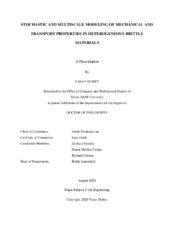| dc.description.abstract | Concrete is one of the widely used synthetic material for construction around the world. Similarly, shale rocks are essential to the oil and gas industry as they are the source formations since the adoption of hydraulic fracturing for the extraction of oil and gas. Therefore, owing to their economic impact, it is necessary to develop an improved predictable model for the effective behavior of these brittle materials. The subscale microstructure of these materials at each length scale, exhibits uncertainty in morphology, composition and properties of the constituent. The objective of this research is to improve understanding and modeling of multiscale behavior of brittle materials by focusing on incorporating uncertainty and propagating to homogenized properties.
In concrete microstructure, the randomness in the morphological features includes size, shape, local volume fraction, spatial distribution of aggregates, and mechanical properties of different phases. We model aggregate as both spherical and irregular shapes of real aggregates embedded in mortar. In this research, we use a nonparametric stochastic model describing the mesoscale mechanical behavior of concrete microstructure, which relies on the theory of micromechanics, random matrix theory, and maximum entropy principle. We calibrated the model using a calibration process based on the numerical homogenization of digitally generated random microstructures. We also utilize this framework to model the time-dependent behavior of concrete, which is crucial to investigate the sustainability of concrete structures.
The study of poromechanical and transport behavior of shale rocks is important for the effective extraction of hydrocarbons. In this research, we utilize multiscale modeling and experimental characterization to improve understanding of poromechanical and damage behavior of shale Different effective medium approximations based on assumptions about subscale morphology are employed to model the homogenized poromechanical property at each level of the multiscale model. A microcrack-induced coupled damage growth and permeability variation model is utilized to simulate damage and transport behavior. Probabilistic descriptions are assigned to key model input parameters at different length scales to account for statistical fluctuation. In order to calibrate model parameters associated with the damage growth model, we conduct direct tensile experiments using a miniature tensile module. | en |


